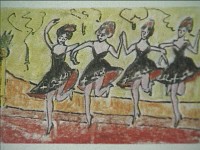
Heckroth, a stage designer by profession, gave many of Jooss’s plays the contemporary expressionist look from a painterly point of view. Oskar Schlemmer developed his choreographies of abstract forms at the Bauhaus from the painter’s perspective. Mary Wigman was inspired by Emil Nolde, among others. Also in the later movement of dance theatre choreographers sought to engage with visual artists, such as Gerhard Bohner![]() with Robert Schad, Johann Kresnik to Gottfried Helnwein or Susanne Linke
with Robert Schad, Johann Kresnik to Gottfried Helnwein or Susanne Linke![]() to VA Wölfl.
to VA Wölfl.
Even in the more recent developments moving in the direction of performance art, the staging of spaces is becoming increasingly important in its own right. For example, the group Neuer Tanz with VA Wölfl is under the direction of a visual artist. But also in numerous pieces by William Forsythe![]() the design of the stage space acquires a sculptural significance.
the design of the stage space acquires a sculptural significance.
(Norbert Servos)
Dance encyclopaedia links
.
People:
Topics:
